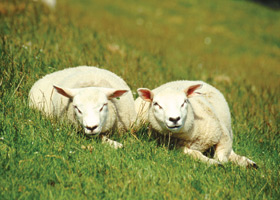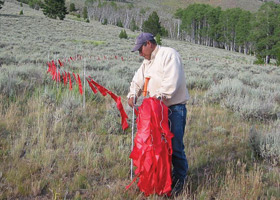Sleeping Among the Sheep

In Central Idaho’s version of the Peaceable Kingdom, the wolf doesn’t lie down with the lamb. But friends of wolves do. It started one summer when a pack of wolves popular with Blaine County residents was slated for removal because of predation on livestock. Volunteers arrived at sheep bed grounds and unrolled sleeping bags, determined to help herders and guard dogs keep wolves away—and unharmed.
The following year Defenders of Wildlife made the program official and hired field assistants to camp out with sheep. By the summer of 2011, in its fourth year, the Blaine County Wolf Coexistence Partnership had become a model for other western states. As Idaho wolves move into Oregon and Washington, federal agencies and Defenders hope the program can be successfully adapted elsewhere.
Idaho’s Wood River Valley, famous for its stunning scenery and Sun Valley ski resort, has a long history of livestock production. Today it acts as a sort of rural highway for range sheep moseying to and from grazing allotments. Last summer, 10,000 sheep either moved through the region or stayed to graze, and of that number, only one sheep was lost to wolf predation
Following a centuries-old practice common to many continents, sheep raisers in the western U.S. move their animals to summer grazing after the snow melts. Sheep allotments are often located in remote or steep areas. The animals must be moved often to avoid overgrazing, so the herder, who tends a band of 1,000 sheep, lives in a metal sheep camp on wheels. A horse, a couple of herding dogs and a couple of guard dogs—often Great Pyrenees or Akbash—provide help.
Field assistants who camp with the sheep employ simple methods to keep wolves away. If the assistant hears wolves or if the flock guardians bark, the assistant shines a spotlight into the night or fires a starter pistol to frighten away the predators. Wolves in the region have been radio-collared, too, so field personnel can keep track of their whereabouts. When wolves get close to flocks, personnel alert the herders.

The program has also borrowed an idea from Eastern Europe—portable fencing and brightly colored flags, devices now available on loan to ranchers. At night, the herder and dogs drive the sheep into a portable pen, then the herder electrifies the fence to keep the sheep confined and places red flags around the enclosure. Mountain breezes make the flags flap, and wolves, leery of movement they don’t understand, stay away.
Defenders of Wildlife Rocky Mountain Region Director Michael Leahy said that along with saving the lives of sheep and wolves, the Blaine County project has demonstrated that conflicts between livestock producers and wolf supporters can be reduced. “We support nonlethal methods to resolve the problems and we’re encouraged that the program has worked so well,” he says.
Kurt Nelson, district ranger for the Ketchum, Idaho, area, said his agency was pleased to back the program and Blaine County has been a good place to test it. “We have fourth- and fifth-generation traditional ranchers and we have progressive ranchers,” Nelson says. “The program has built a bridge between livestock producers and wolf supporters.”
Peter Haswell, a wildlife biologist with the UK Wolf Conservation Trust who worked previously with Defenders, says the program aims to make livestock an unattractive prey source. “It’s all about energy economics with predators,” Haswell says. “We try to make the livestock hard to prey on.”
Blaine County Commissioner Lawrence Schoen got a unique perspective on humans and wild predators living in close proximity when he visited African countries. There, he says, “The presence of these animals is keenly felt, tremendously exciting, ennobling and humbling.”
Suzanne Stone, Northern Rockies representative for Defenders, said she sees the benefits of reintroduced wolves. “Aspens, willows, and cottonwoods are healthier because there isn’t so much overgrazing,” she says. “We have stronger beaver and songbird populations.” She hopes to see wolves fully integrated back into the region.

